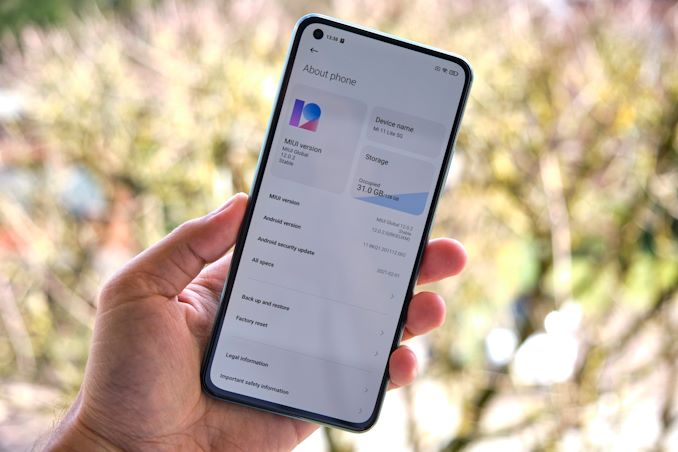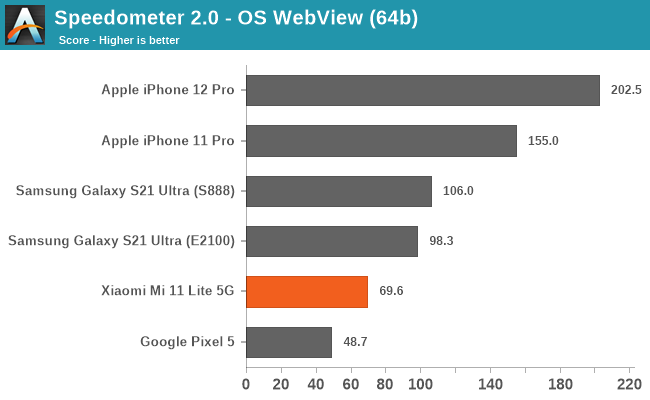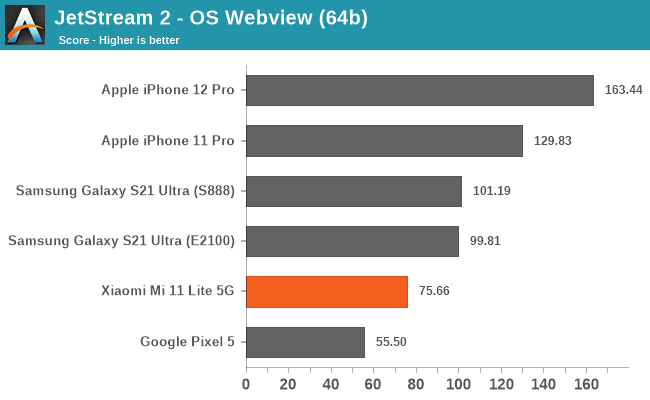Xiaomi Mi 11 Lite 5G Performance Report: First Taste of the Snapdragon 780G
by Andrei Frumusanu on April 13, 2021 9:00 AM EST
It’s only been a couple of weeks since Qualcomm first announced its new “premium” range SoC for 2021: the new Snapdragon 780G. The chip is a successor to the Snapdragon 765 which ended up being a quite successful and popular chip among 2020 mid-range and “premium” segment devices, powering many devices such as for example the Pixel 5 and 4a 5G.
Also a couple of weeks ago, Xiaomi had made a flurry of device announcements among the Mi 11 Ultra as the new mega-flagship device for 2021. One device we didn’t have time to cover was the new Mi 11 Lite 5G. Beyond the super interesting form-factor of a 6.8mm thick device and weighing in only 159g despite its larger 160.5 x 75.5mm footprint, as well as higher quality OLED display, the phone differentiated itself by being the very first Snapdragon 780G phone in the market.
We’ve got our hands on a review sample, and wanted to dedicate a piece focusing a bit more on the SoC, as the new chip will be powering not only the Mi 11 Lite 5G, but undoubtedly a whole lot of other mid-range and premium devices in the coming months.
| Qualcomm Snapdragon Premium SoCs | ||||
| SoC | Snapdragon 765 Snapdragon 765G |
Snapdragon 768G |
Snapdragon 780G |
|
| CPU | 1x Cortex-A76 @ 2.3GHz (non-G) @ 2.4GHz (765G) 1x Cortex-A76 @ 2.2GHz 6x Cortex-A55 @ 1.8GHz |
1x Cortex-A76 @ 2.8GHz 1x Cortex-A76 @ 2.4GHz 6x Cortex-A55 @ 1.8GHz |
1x Cortex-A78 @ 2.4GHz 3x Cortex-A78 @ 2.2GHz 4x Cortex-A55 @ 1.9GHz |
|
| GPU | Adreno 620 |
Adreno 620 +15% perf over 765G |
Adreno 642 +50% perf over 768G |
|
| DSP / NPU | Hexagon 696 HVX + Tensor 5.4TOPS AI (Total CPU+GPU+HVX+Tensor) |
Hexagon 770 Scalar+Tensor+Vector 12TOPs AI (Total CPU+GPU+DSP) |
||
| Memory Controller |
2x 16-bit CH @ 2133MHz LPDDR4X / 17.0GB/s |
|||
| ISP/Camera | Dual 14-bit Spectra 355 ISP 1x 192MP or 1x 36MP ZSL or 2x 22MP with ZSL |
Triple 14-bit Spectra 570 ISP 1x 192MP or 1x 84MP ZSL or 2x 64+20MP ZSL or 3x 25MP ZSL |
||
| Encode/ Decode |
2160p30, 1080p120 H.264 & H.265 10-bit HDR pipelines |
|||
| Integrated Modem | Snapdragon X52 Integrated (LTE Category 24/22) DL = 1200 Mbps 4x20MHz CA, 256-QAM UL = 210 Mbps 2x20MHz CA, 256-QAM (5G NR Sub-6 4x4 100MHz + mmWave 2x2 400MHz) DL = 3700 Mbps UL = 1600 Mbps |
Snapdragon X53 Integrated (LTE Category 24/22) DL = 1200 Mbps 4x20MHz CA, 256-QAM UL = 210 Mbps 2x20MHz CA, 256-QAM (5G NR Sub-6 4x4 100MHz) DL = 3300 Mbps UL = ? Mbps |
||
| Mfc. Process | Samsung 7nm (7LPP) |
Samsung 5nm (5LPE) |
||
On paper, the new Snapdragon 780G is a major upgrade from the Snapdragon 765G. The new SoC features not only upgraded CPU microarchitectures, actually jumping from a Cortex-A76 generation to a newer Cortex-A78 generation, but also shifts from a 1+1+4 core setup to a 1+3+4 setup, meaning the new SoC has double the amount of performance CPU cores. The clock frequency remains at a peak 2.4GHz for the fastest core in the configuration.
This setup is quite interesting as it’s quite similar to the middle CPU cores of the Snapdragon 888 flagship SoC, which employs the same microarchitecture at roughly the same clocks, and both chips are manufactured on Samsung’s 5nm 5LPE process node. There are differences in the memory setup as the Snapdragon 780G remains on a LPDDR4X interface that’s only 2x16b wide, which is smaller than the LPDDR5 4x16b bus that the flagship SoC gets. There’s also differences in caches such as the L3 cache being much smaller.
CPU Performance & Efficiency
Comparing the performance and power efficiency of the new chip compared to not only its predecessor, but also its current generation flagship sibling, we should be able to paint a better picture of how the new chip sits in the competitive landscape.
In SPEC2006, the new chip – albeit running at the same frequency as the Snapdragon 765G, is showcasing significant performance leaps compared to its predecessor. We’re seeing roughly +34% performance improvements in both integer and floating point test suites, not quite 40% as Qualcomm had proclaimed, but that’s also an “up to” figure depending on the workload.
In the performance positioning, we indeed see that the performance core of the Snapdragon 780 roughly matches up to the middle cores of the Snapdragon 888, which is expected given their similar specifications. The S888 wins out ahead due to a stronger memory subsystem.
In terms of power and energy efficiency, it’s an interesting situation. In terms of power usage, we see that the performance increases did come with a cost, as the new chip is roughly +20% more power hungry as its predecessor in single-threaded tasks. Due to the performance increase being higher than the power increase however, the energy efficiency of the new chip is actually higher than its predecessor, showcasing 8 to 13% less energy usage to complete a task, which should have direct effects on the battery life of devices.
In general, the larger performance increase combined with a reduction in energy usage of the new SoC means that it’s a pretty significant generational leap against the Snapdragon 765.
A bit unrelated to the Snapdragon 780, last month Google had finally pushed AArch64 versions of Chrome and the system WebView packages, signifying an important shift away from AArch32 32-bit era. This actually has a larger impact on benchmarks as newer Arm Cortex microarchitectures have more significant differences (relative to past ones) between the two execution modes, with the AArch64 mode being more performant and more efficient. For this reason, we’re starting with a new clean slate of test results with explicitly stated (64b) in the graphs.


We’re comparing the Mi 11 Lite 5G to the Pixel 5 here as the Mi 10 Lite 5G with the Snapdragon 765G unfortunately is still being deployed 32-bit packages due to its lower 6GB RAM, and we still want an apples-to-apples comparison.
In the JetStream 2 and Speedometer 2.0 browser benchmarks we’re seeing +36-43% performance increases compared to the Snapdragon 765G, which are significant boosts. The Snapdragon 780G still clearly lags behind the performance of the flagship SoCs, signifying that there’s still plenty of performance differentiation to be had between the segments.
Excellent User Experience
In general, the performance leap of the Snapdragon 780G is quite significant. The new CPU microarchitecture delivers large generational IPC boosts and the fact that the new chip has double the big performance cores also helps out multi-threaded workloads a lot.
Truth be told, it’s a vast shift in user experience as the device definitely feels much faster and snappier than Snapdragon 765G devices. It roughly lands in between the Snapdragon 855 and Snapdragon 865 flagship generations in terms of overall device experience, which is not surprising as that’s also exactly where the new chip benchmarks itself at.











25 Comments
View All Comments
zentwo - Tuesday, April 13, 2021 - link
It has been suggested in some reviews that there is thermal throttling on the Mi 11 Lite 5G after around 5 minutes of benchmarking, while there is no throttling on the 4G version with the 732G. So it may be interesting to also test thermal throttling of this device.Andrei Frumusanu - Tuesday, April 13, 2021 - link
The sustained performance metrics in the GPU section are extended +30 minute throttling levels. There is a little bit of it but nothing substantial or problematic.Kangal - Wednesday, April 14, 2021 - link
Thanks Andrei for the review.I'm a bit surprised that Qualcomm released a chipset this fast and this efficient. Normally at this price point, I would've expected late 2022, as that's how slow Qualcomm's being with their mid-range chips. They must either be shifting strategy, being mindful of the competition, or something else.
The "something else" I feel like is ARMv9. There might be a divide coming, like there was during the 2014-2016 transition of 32bit and 64bit phones. It was particularly nasty from the software update path, when comparing Android 4.4 to 5.1
Any thoughts on that matter?
ZolaIII - Wednesday, April 14, 2021 - link
Midrange is 50% of all mobile SoC's sold and counts in for 70% of all mobile SoC's QC sells. Short answer is competition or better said higher tier of MTK Dimemsity SoC's. This way QC will stay at least one and a half steep ahead (better 5G and A78 core's).mekpro - Tuesday, April 13, 2021 - link
What is the cache size of this 780G ?Chaser - Tuesday, April 13, 2021 - link
Got to love progress. I am not a phone gamer. So a powerful midrange SoC like this one is very interesting.Linustechtips12#6900xt - Tuesday, April 13, 2021 - link
I love these new powerful midrange phones and chips, super power-efficient and I don't game or whatever besides some minor clash of clans or something like that stupid so it makes total sense to me rather than getting a phone with an sd888 and having worse battery life.KarlKastor - Tuesday, April 13, 2021 - link
@AndreiCan you say something to cache sizes and GPU clock?
Such data is available to the flag ship SoC, but never for the smaller ones.
Would be interesting for the 765, 750 and 730 too.
Wardrive86 - Tuesday, April 13, 2021 - link
I wonder if any of the GPU tests truly stress memory bandwidth. The Adreno 642(780G) outperforms the Adreno 640(855) in these benchmarks with half the memory bandwidth. As they are both Adreno 600 parts im assuming no new compression techniques are in use.iphonebestgamephone - Thursday, April 15, 2021 - link
Its only outperforming in the aztec normal test. I did some tests on my 855 device and got 44 and 17 fps on normal and high respectively. The sustained results are a matter of efficiency. Looks like the bandwidth doesnt matter much for benchea or games. 780g perfroms the same as 855 even in genshin impact.